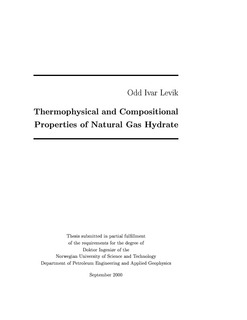| dc.contributor.author | Levik, Odd Ivar | nb_NO |
| dc.date.accessioned | 2014-12-19T11:24:52Z | |
| dc.date.available | 2014-12-19T11:24:52Z | |
| dc.date.created | 2000-11-27 | nb_NO |
| dc.date.issued | 2000 | nb_NO |
| dc.identifier | 125413 | nb_NO |
| dc.identifier.isbn | 82-7984-124-5 | nb_NO |
| dc.identifier.uri | http://hdl.handle.net/11250/231248 | |
| dc.description.abstract | Thermophysical properties (dissociation enthalpy, heat capacity, metastability) and compositional properties (hydrate number, free water and fractionation) of natural gas hydrate were studied experimentally on samples that contained large amounts of ice. Methods for continuous hydrate production and sampling, and for quantification of the properties were developed. Hydrate was produced from a natural gas of ethane (5 %mol) and propane (3 %mol) in methane.
A low temperature scanning calorimetry method was developed to measure dissociation enthalpy, heat capacity, hydrate number and free water (ice). During the analysis, the hydrate samples were pressurized to 1.7 MPa with methane and the system operated between the hydrate equilibrium curves of methane and the hydrate forming natural gas. A sample conditioning procedure eliminated thermal effects of desorption as the ice melted. Desorption occurred since the samples were produced and refrigerated to 255 K under a natural gas pressure of 6-10 MPa, but were analyzed and melted under a methane pressure of 1.7 MPa.
A low temperature isothermal calorimetry method was developed to quantify the metastability properties. Metastability was confirmed for temperatures up to 268 K and quantified in terms of the low dissociation rate.
Fractionation data were obtained in the range 3.0 to 7.5 MPa and for subcoolings between 2 and 16 K. High pressure and large subcooling is desirable to suppress fractionation. A fractionation model was proposed. The model coincides with the van der Waals-Platteeuw model for zero subcooling. No fractionation is assumed for hypothetical hydrate formation at infinite driving force (subcooling). Between these two extremes an exponential term was used to describe the fractionation. The model predicted fractionation with an accuracy of about 1%abs corresponding to 1-10%rel. | nb_NO |
| dc.language | eng | nb_NO |
| dc.publisher | Fakultet for ingeniørvitenskap og teknologi | nb_NO |
| dc.relation.ispartofseries | Dr. ingeniøravhandling, 0809-103X; 2000:97 | nb_NO |
| dc.subject | Geophysics | en_GB |
| dc.subject | NATURAL SCIENCES: Physics: Other physics: Geophysics | en_GB |
| dc.title | Thermophysical and compositional properties of natural gas hydrate | nb_NO |
| dc.type | Doctoral thesis | nb_NO |
| dc.source.pagenumber | 164 | nb_NO |
| dc.contributor.department | Norges teknisk-naturvitenskapelige universitet, Fakultet for ingeniørvitenskap og teknologi | nb_NO |
| dc.description.degree | dr.ing. | nb_NO |
| dc.description.degree | dr.ing. | en_GB |
